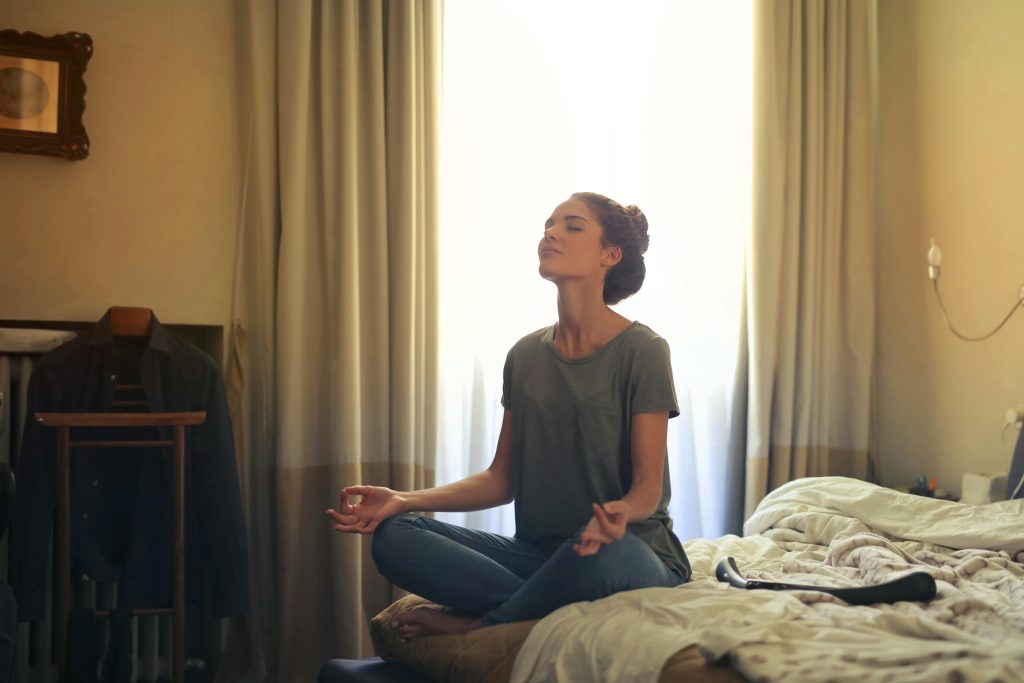Life can be overwhelming. Between juggling work, relationships, that alarming pile of laundry in the corner, and the existential dread brought on by watching the news, it’s no wonder many of us feel like we’re teetering on the edge of sanity. So, what’s the solution? Move to a remote mountain, grow a beard, and meditate until you transcend to another dimension? Well, maybe… but for the rest of us who have to keep the Wi-Fi on and survive the real world, building a home sanctuary for mental health might be a better (and more practical) idea. Plus, no beard required!
Creating a mental health sanctuary at home doesn’t mean you need to convert your living room into a yoga studio or start burning sage every time you send an email. It’s about cultivating an environment that helps you unwind, recharge, and connect with your inner calm… even when your neighbor’s dog won’t stop barking. So, buckle up, because we’re going to dive into how you can turn your home into a wellness retreat without having to explain to visitors why you’ve hung up dreamcatchers in the bathroom.
1. Start with a Declutter (Marie Kondo-ish, But With Less Pressure)
We’ve all heard the phrase, “A cluttered space equals a cluttered mind.” And there’s some truth to that, even if your personal mountain of random mail and Amazon boxes seems to argue otherwise. The first step in building your home sanctuary is decluttering, but let’s approach this with realistic expectations.
Don’t worry about folding your socks into origami shapes or asking each item in your house if it “sparks joy”—if your couch sparks joy, great; if your couch sparks naps, that’s even better. The goal here is to remove the excess stuff that’s causing visual chaos and low-key stress.
Take it room by room. Start with your most lived-in spaces (you know, the places where you collapse at the end of the day), and get rid of anything that isn’t useful or beautiful. Bonus points if you find things you didn’t even know you owned! Why do you have three spatulas when you barely cook? Ah, the mysteries of life.
Remember, decluttering isn’t just about creating physical space; it’s about making mental space. Fewer distractions mean more room to focus on what really matters, like pretending to be productive while scrolling TikTok.
Join Our Mailing List
Register now to get our hints and tips newsletter directly to your inbox
2. Bring In the Plants (AKA Nature’s Therapy Without the Bugs)
Plants are like therapy with roots—they don’t talk back, they don’t judge your life choices, and they make everything look Instagram-worthy. Plus, studies show that being around greenery can reduce stress and boost your mood. It’s like Mother Nature’s way of saying, “Chill out, human. I got this.”
But before you go wild and turn your house into a jungle, let’s talk about the kind of plants that are actually good for your mental health (and your self-esteem). You want plants that thrive on minimal care, because the last thing you need is to feel guilty about killing yet another succulent.
Here are some plant ideas that even you (yes, you) can keep alive:
- Snake Plant: This guy is practically invincible. Water it every few weeks and it’ll still love you.
- Spider Plant: Not as creepy as it sounds! It’s low-maintenance and filters the air.
- Aloe Vera: Besides being soothing for your skin, it’ll give you the illusion that you’re basically a green-thumbed wizard.
If you’re feeling particularly ambitious, you can even try a tiny herb garden in your kitchen. Basil and mint smell amazing, and you can toss them in your cooking (which may or may not happen often, but hey, it’s an option).
3. Create a Relaxation Zone (No Work, No Stress Allowed)
Now that your space is less cluttered and you’ve adopted some leafy new friends, it’s time to create a designated relaxation zone. Think of this as your personal chill-out corner where stress is banished, and naps are encouraged.
First, let’s establish the Golden Rule of the Relaxation Zone: No work allowed. That’s right—no laptops, no emails, and definitely no bringing in that stressful to-do list. This is your sanctuary for unwinding, not a place for remembering you have ten unanswered Slack messages.
So, what should be in this zone? Think cozy, think soft, think “I never want to leave this spot” vibes. Here’s a checklist to get you started:
- Comfy seating: Whether it’s a plush chair, a bean bag, or a pile of pillows, make sure it’s something you can sink into and forget your troubles.
- Soft lighting: Overhead lights are the enemy here. Opt for soft lamps, fairy lights, or even candles to create a warm, soothing ambiance. Bonus points for candles that smell like vanilla, lavender, or “I’m definitely more relaxed than I look.”
- Blankets: Because no sanctuary is complete without something you can wrap yourself in, burrito-style.
If you’re feeling extra fancy, you can add a small speaker for calming music or nature sounds. The sound of ocean waves is scientifically proven to make you feel like everything’s going to be okay, even when your Wi-Fi is down.
4. Get a Little Hygge With It (Embrace the Cozy Vibes)
Speaking of cozy, let’s take a page from the Danish and their obsession with hygge (pronounced “hoo-gah”). Hygge is all about creating a sense of coziness, contentment, and well-being, and you can easily channel those vibes into your home sanctuary.
The essence of hygge is simplicity and comfort. It’s sipping a hot cup of tea under a warm blanket while the rain gently taps on the window. It’s taking a break from the chaos of life to enjoy a quiet moment. It’s also a great excuse to buy more blankets and candles, just saying.
Here’s how to infuse some hygge into your sanctuary:
- Textured fabrics: Think soft throws, chunky knit blankets, and oversized cushions. The kind of textures that make you want to curl up with a book (or a Netflix marathon).
- Warm beverages: Tea, coffee, or even hot chocolate with an absurd amount of marshmallows. Hygge is about savoring the moment, so drink something that makes you feel cozy inside.
- Unplug: Hygge is about being present, so take some time to disconnect from your screens. Unless you’re reading this on your phone right now, in which case… carry on.
5. Mind Your Senses (Appeal to Your Inner Zen Master)
Your home sanctuary should be a full sensory experience. After all, mental health isn’t just about what you see—it’s about how your environment makes you feel. So, let’s tap into all five senses (without getting too weird about it).
- Smell: Essential oils are your friend here. Lavender is calming, eucalyptus is refreshing, and citrus can boost your mood. You can use a diffuser, candles, or even some good old-fashioned potpourri if you’re feeling retro.
- Touch: We already talked about soft blankets, but don’t stop there. Consider textures in your space that make you feel comfortable and grounded. A cozy rug, smooth stones, or even one of those squishy stress balls can help.
- Sound: Nature sounds, instrumental music, or even silence—whatever soothes your soul. Just make sure your playlist doesn’t accidentally throw in a high-energy pop song that jolts you out of relaxation mode.
- Sight: We’ve covered decluttering, but also consider the colors in your space. Soft, muted tones like blues, greens, and earthy hues can promote calmness, while neon orange… maybe not so much.
- Taste: This one’s easy—snacks! Keep a small stash of your favorite treats in your sanctuary (preferably something healthy-ish). Dark chocolate, nuts, or a fresh fruit bowl can be nourishing without the guilt of binging on a full bag of chips.
6. Personalize It (Make It Yours, Not Pinterest’s)
Now that you’ve got the basics down, it’s time to add some personal touches. A home sanctuary isn’t about making your space look like it belongs in a magazine—it’s about making it a reflection of you.
Do you love art? Hang up prints that inspire you. Got a favorite book? Keep it nearby for those moments when you need a mental escape. Maybe you have a quirky collection of objects from your travels—put them on display. The key is to create a space that feels like home, not a showroom.
You can also add in mindfulness elements like a meditation cushion, a journal for brain-dumping your thoughts, or a gratitude jar where you toss in notes about things that made you smile that day. (Yes, even if it’s just that you remembered to water your plants.)
7. Set Boundaries (Protect Your Zen at All Costs)
The final step to building a home sanctuary for mental health? Boundaries. You’ve created this beautiful, relaxing space—now you need to make sure it stays that way. Set clear rules about when and how you’ll use your sanctuary.
This means no checking work emails in your relaxation zone, no doomscrolling, and definitely no inviting drama into your sacred space. Think of your sanctuary as your mental health bubble—only good vibes allowed.
And if anyone tries to burst that bubble (looking at you, unannounced visitors), just politely point to the “Do Not Disturb” sign you might want to hang on your door. And yes, you absolutely deserve a “Do Not Disturb” sign. It’s your sanctuary—no interruptions, no stress, no chaos. Even if that means you have to stare your roommate or partner down when they casually wander in asking if you’ve seen the TV remote.
8. Embrace Imperfection (Because Life Is Messy)
Now, here’s the thing: your home sanctuary doesn’t have to be perfect. In fact, chasing perfection will only cause more stress—which kind of defeats the purpose, right? If your “relaxation zone” gets taken over by laundry for a day or two, or your cat claims your cozy chair as their new kingdom, don’t stress it. Remember, this space is here to serve you, not the other way around.
Your home sanctuary should be flexible and evolve with your needs. If one week, it’s all about lighting candles and journaling, great. If the next week, it’s about watching reruns of your favorite sitcom with a big bowl of popcorn, that’s cool too. The important thing is that you have a space that helps you recharge, even if it’s not Insta-perfect.
9. Bonus Tip: Laugh at Yourself
Building a home sanctuary for mental health is serious business… except it’s not. The ultimate key to mental wellness is learning not to take everything too seriously, including the process of creating your sanctuary. If your DIY plant shelf falls apart, laugh it off. If you light a calming candle and accidentally knock it over with your elbow, well, at least you’re providing comic relief for yourself.
Incorporating humor into your daily life is one of the most underrated mental health hacks out there. Laughter releases endorphins, reduces stress, and helps you maintain perspective. So, when life throws you curveballs—or if your zen space is interrupted by your neighbor’s loud vacuuming—just chuckle at the absurdity and carry on.
Conclusion: Your Home, Your Peace
Creating a home sanctuary for mental health doesn’t require a complete home makeover, an Instagram aesthetic, or a deep knowledge of feng shui. It’s about making intentional choices that bring you peace, comfort, and joy in your own space—whether that’s through soft lighting, a pile of cozy blankets, or simply setting boundaries around your time and energy.
By decluttering, bringing in plants, embracing hygge, and minding your senses, you’re well on your way to turning your home into a place that nurtures your mental health. And remember, the ultimate goal is to create a space that’s as unique and comforting as you are—not Pinterest, not Marie Kondo, and definitely not your neighbor’s idea of a Zen temple.
So go ahead, light that lavender candle, cuddle up in your softest blanket, and claim your corner of the world where stress isn’t invited. You deserve a space that feels like a warm hug, no matter how messy life gets. Welcome to your sanctuary, where mental peace is the ultimate home decor.
Now, if you’ll excuse me, I’m off to declutter my coffee table… or at least shuffle the clutter around to look more organized. Close enough, right?




